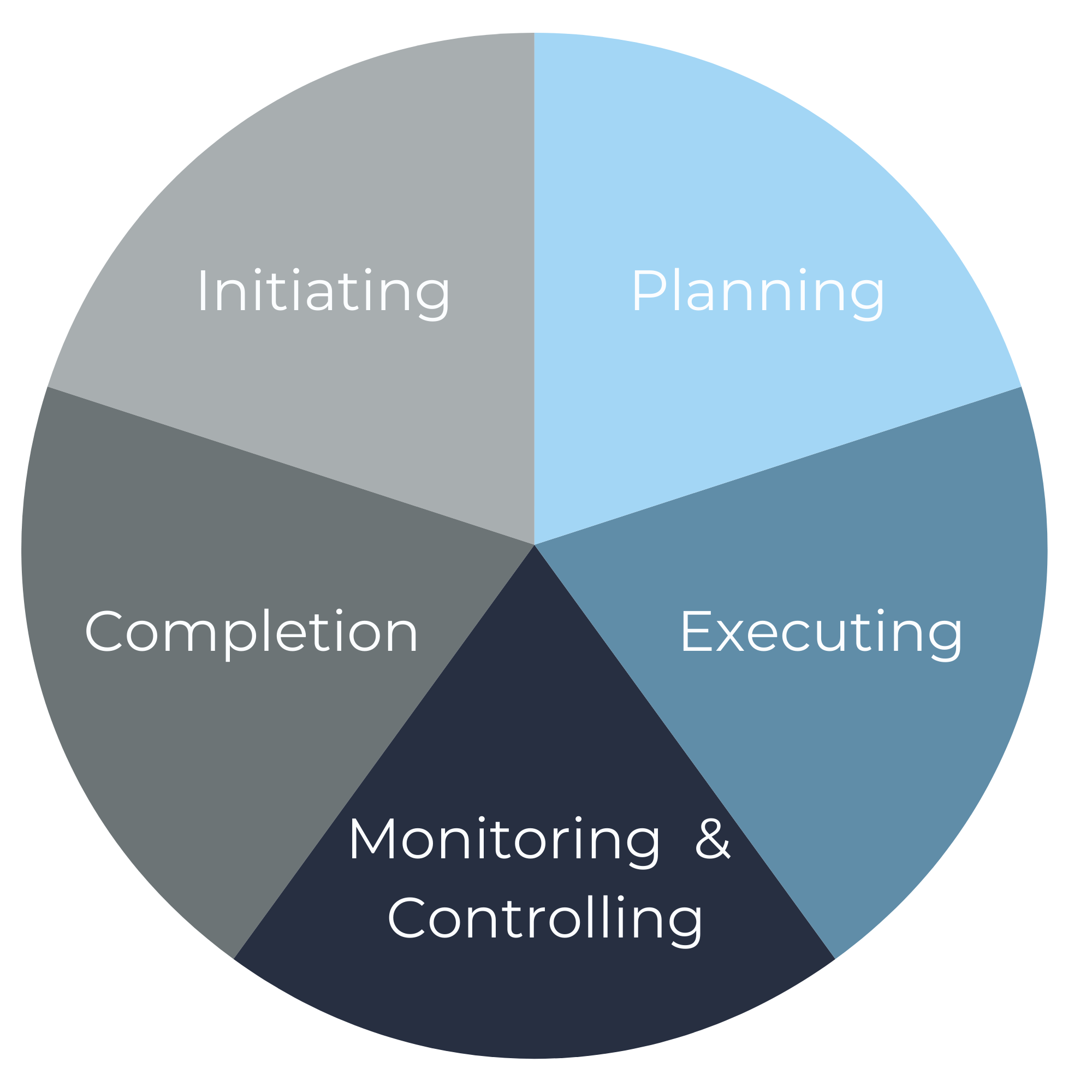The Lawyer’s Guide to Project Management

What is Project Management?
Project management has been around for decades and while its roots were in product development, it is becoming widely-used in service-based businesses as well. The leading industry accreditor, the Project Management Institute (PMI), defines project management as:
[T]he use of specific knowledge, skills, tools and techniques to deliver something of value to people.
Project management as a formal profession dates back to the late 1960s, but project management has been practiced informally for centuries. Lawyers are a good example. Each of us has “specific knowledge, skills, tools, and techniques” that we rely on to deliver results to our clients. You’ve probably been a project manager for most of your legal career.
What is a “project”?
There are several characteristics of a project:
- Temporary endeavor with a beginning and an end
- Different from routine business operations
- Its own budget, schedule, and team
- Concluded once the goal is achieved
Legal matters meet each of these elements of a “project:” (i) a matter has a beginning (when you start work on a new matter) and an end (when the case is over of the transaction is closed); (ii) practicing law may be the lawyer’s routine activity, any particular matter is not – operations are things like accounting, payroll, personnel decisions, etc.; (iii) matters have their own timeline and should have their own budget, they also have their own team of attorneys; and (iv) once the case or transaction is resolved, the matter is over.
Next, we are going to cover some of the key concepts of project management.
Key Concept 1:
The Five Phases of a Project
Whether it is a legal matter, construction of a building, or bringing a new software product to market, each project goes through the same five phases:
- Initiating – This is where we define project goals, create the business case, and identify the key stakeholders
- Planning – In this phase, we define the scope of the work, create a plan, set a budget, and determine the roles and responsibilities for the people involved
- Executing – Now it is time to carry out the work that will lead us to the result we want. This phase also includes adjusting and adapting to new information and new needs that may arise
- Monitoring & Controlling – While it’s good to adapt as you go, this phase insures that changes are managed and reflected in the budget, schedule, etc.
- Completion – This is more than just being “done.” Its the time for reviewing the project, documenting the learnings, and close out the matter.


Key Concept 2:
Project Constraints
Everyone’s time is limited and for most of us, so is our money. A project manager works within these constraints with the understanding that changing one will affect the other two:
- Time – Much of law is deadline-driven so it should come as no surprise that time is a significant factor in managing a project. A project manager makes sure the right work is being done in the right way, and at the right time.
- Scope – The amount of work that needs to be done. The scope of a matter changes depending on the goals of the client and usually the budget. It is also related to quality. A project manager ensures work meets or exceeds expectations – within the scope.
- Budget – The amount of money it takes to get the work done, taking into account who is doing the work. The project manager is constantly monitoring costs as compared to budget so that adjustments may be made.
Key Concept 3:
The Critical Path
There are many tasks that need to be done in any legal matter. But which are the ones that must be done? This is a stringent test – it is the minimum set of tasks required to resolve your matter on time. Other tasks may be important but can be rescheduled or reduced if time is limited or things change. Think about discovery – perhaps you would like to depose all the relevant employees of the other party. But you only have two other attorneys who can take the depos, and you need to file a motion for summary judgment in two months. You are going to have to eliminate some people on your list and identify which deponents are the most critical – the “must depose” list. All other discovery will have to work around those depositions.
Key Concept 4:
Resources and Tools
Projects – including legal matters – can be complex and a manager has many responsibilities including scheduling, planning, and monitoring to make sure projects run smoothly. Fortunately, there are tools and resources out there to keep things manageable. Google “project management software” and you will be overwhelmed with the hundreds of tools available. Choosing one can be a challenge. Your project manager can help you find one that is right for you. Whichever tool you use, it needs to have a powerful reporting features such as:
Dashboards

Dashboards display the key metrics from all parts of a project. This information is typically displayed in charts and graphs so that a manager or lead attorney can easily see progress.
Gantt Charts

Gantt charts are a project management staple. They are a graphic representation of your task list overtime. Using Gantt charts, the project manager can see the relationships between tasks – such as a task that is dependent on another one being completed.
The Language of Project Management
Now you know what a project is, and what project management is. You’ve learned about Gantt charts and dashboards, and heard some common terms to describe the stages of a project. Here’s a quick summary of those terms and a few others that can help lawyers better understand project management.
Agile Agile is a specific approach to project management. It is built on “sprints” or short bursts of work. Typically used in software development, it is a flexible working style allowing for multiple iterations between initiation and completion.
Change Management You can probably figure out that this refers to managing changes that occur during a project. It is worthy of it’s own plan because it ensures changes – and their effects on budget and scope – are communicated to the team and clients.
Dashboards Like the dashboard of your car, these allow project managers and others get a quick visual overview of the matter.
Deliverable Each task or series of tasks results in an output – this is a deliverable. A deliverable might be something like a brief, a deposition outline, or an exhibit notebook.
Dependency This is a relationship between tasks or groups of tasks where one task is dependent on another being completed – or sometimes just started.
Gantt Chart A bar chart where tasks are displayed over time. It is useful for identifying dependencies and other relationships among tasks.
Milestone This a significant point in time during the project where something significant is created. This could be like completing all percipient witness depositions, reaching a deal, or other important moments before a matter is closed.
Project A temporary endeavor to create value through a unique product, service, or result. (PMI)
Project Management The use of specific knowledge, tools, and techniques to deliver something of value to people. (PMI)
Scrum A scrum is part of an agile approach and is led by the “scrum master.” Like agile, it is typically used in software development with incremental processes. It’s also on my “beware of project management theater” list (see below).
Stakeholder A stakeholder is a person who is engaged in and/or influenced by the project. Stakeholders can be internal or external and may include attorneys, staff, firm accounting and business development departments, and especially, clients. Projects must meet the needs of the stakeholders.
Triple Constraint This is a term used to describe the limitations on projects discussed above: time, scope, and budget.

Beware of Project Management Theater
Project management may be relatively new to attorneys and law firms, but it is not unheard of. And like anything new, we are attracted to it like a shiny penny. It reminds me of IT professionals when I first started practicing law – no one really new what they did but they made magic things happen, for which law firms paid a lot of money. Not that IT departments are not essential and valuable, but there were few standards to judge them by. It was easy to be taken in with the widgets and gadgets – “IT Theater” so to speak.
I believe we are in a similar phase with legal project management. There are professionals out there performing what I call “Project Management Theater” who throw around a lot of the “cool terms” like “scrum” and “huddle” but lack the skills to actually manage projects. Firms are vulnerable because they don’t really know what “project management” is. (Which is one reason we call our work Advanced Matter Management.)
Your legal project manager should be knowledgeable about project management principles, but should also have a demonstrated ability to put those principles into action. Hopefully this post has helped you understand the basics of project management so you can make smart hiring decisions when you’re ready to bring on your first project manager.

